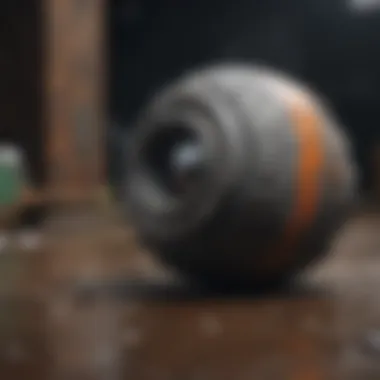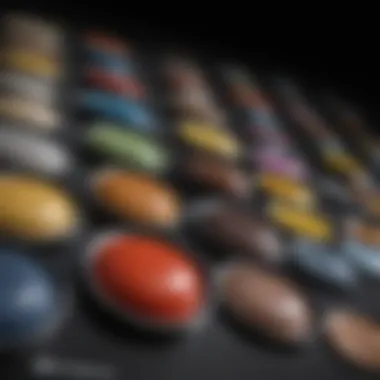Mastering the Art of Removing Old Paint: A Comprehensive Guide


Overview of the Topic
When it comes to the meticulous task of removing old paint, it is crucial to have a comprehensive understanding of the process to ensure a seamless renovation experience. This article serves as a detailed roadmap for individuals seeking to refresh their living spaces by delving into the nuances of eliminating old paint efficiently. From identifying different types of paints to implementing expert removal techniques, this guide offers valuable insights for anyone embarking on a paint removal project.
Current Methods and Challenges
The current methods employed for removing old paint vary in effectiveness and environmental impact. Traditional methods such as scraping and sanding can be labor-intensive and may release harmful paint particles into the environment. This poses a challenge not only in terms of efficiency but also in maintaining environmental sustainability during renovation projects. Additionally, the presence of lead-based paints in older structures adds another layer of complexity and risk to the removal process, requiring careful consideration and adherence to safety protocols.
Sustainable Practices and Innovations
In light of the challenges posed by traditional paint removal methods, there is a growing emphasis on embracing sustainable practices and innovative solutions in the field. Environmentally friendly paint strippers, for instance, offer a safer alternative to harsh chemicals, reducing the ecological footprint of renovation projects. Furthermore, technologies such as infrared paint removal systems have gained traction for their effectiveness in removing multiple layers of paint without generating dust or debris, promoting a cleaner and safer work environment.
Impact on Ecosystems and Importance of Conservation
The impact of old paint removal extends beyond the confines of individual living spaces, affecting ecosystems and communities at large. Improper paint disposal can contaminate soil and water sources, posing risks to wildlife and human health. By highlighting the importance of responsible paint removal practices, this guide underscores the significance of conservation efforts in preserving natural resources and ensuring the well-being of current and future generations. Through informed decision-making and sustainable approaches, individuals can mitigate the environmental impact of paint removal and contribute to a more eco-conscious renovation culture.
Understanding Old Paint
Old paint removal is a meticulous process that requires a deep understanding of different paint types. It sets the foundation for a successful renovation by providing crucial insights into the nature of the existing paint layers. Recognizing the type of paint utilized is essential in determining the most effective removal method, ensuring a seamless transition to a fresh coat. This section delves into the nuances of paint identification, highlighting the significance of knowing the composition of old paint before embarking on removal procedures.
Identification of Paint Types
Oil-based Paints
Oil-based paints hold a distinct position in the realm of old paint varieties, renowned for their durability and classic finish. They offer unmatched adhesion to various surfaces, making them a preferred choice for long-lasting applications. The key characteristic of oil-based paints lies in their ability to create a robust protective coat, ideal for high-traffic areas or surfaces prone to moisture exposure. Despite their resilience, oil-based paints require additional caution during removal due to their solvent-based composition.
Latex Paints
Latex paints, also known as acrylic paints, have gained popularity for their quick drying time and easy cleanup with water. Their versatility and non-yellowing properties make them a go-to option for interior paints. The key characteristic of latex paints is their flexibility and breathability, allowing them to adapt to various environmental conditions without compromising durability. While latex paints are relatively easier to remove compared to oil-based paints, proper assessment is necessary to ensure a smooth removal process.
Lead-based Paints
Lead-based paints, once a common choice for their durability and color retention, now pose significant health and environmental risks. The key characteristic of lead-based paints is their toxic lead content, which can have adverse effects on human health, particularly children and pregnant women. Understanding the presence of lead in old paint is crucial to implementing safe removal practices and preventing lead exposure. Despite their hazardous nature, lead-based paints were prevalent in older structures and require careful handling and disposal to minimize health hazards.
Assessment of Paint Condition
Peeling


Peeling paint, characterized by paint layers detaching from the surface, indicates poor adhesion or moisture infiltration. Addressing peeling paint is essential to prevent further damage and achieve a smooth paint removal process. It is crucial to identify the root cause of peeling, whether from surface preparation issues or environmental factors, to apply the appropriate removal techniques effectively.
Chipping
Chipping paint, evident in paint layers forming loose fragments, signifies wear and tear or impact damage. Dealing with chipping paint involves understanding the underlying substrate condition and selecting suitable removal methods. Proper evaluation of chipping areas ensures thorough removal without causing additional surface damage, facilitating a successful paint renovation project.
Cracking
Cracking paint, characterized by fissures or lines on the surface, indicates aging or structural movement issues. Managing cracked paint involves assessing the extent of damage and selecting compatible removal approaches. By addressing underlying causes of paint cracking, such as temperature fluctuations or inadequate surface preparation, a comprehensive paint removal plan can restore the surface to its former glory.
Health and Environmental Concerns
Impact of Lead Paint
The impact of lead paint on human health is a critical concern in old paint removal projects due to lead's neurotoxic properties. Exposure to lead dust or fumes from lead-based paints can lead to severe health complications, making it imperative to implement safe removal practices. Understanding the risks associated with lead exposure equips individuals with the knowledge to protect themselves and the environment from potential harm.
Respiratory Risks
Respiratory risks in paint removal stem from inhaling dust particles or volatile organic compounds (VOCs) released during the process. Proper ventilation and respiratory protection are vital in mitigating respiratory hazards, safeguarding individuals from lung irritation or long-term health effects. By prioritizing respiratory health during paint removal, adverse respiratory outcomes can be minimized, ensuring a safe and healthy work environment.
Proper Ventilation
Ensuring proper ventilation during paint removal activities is essential to prevent the buildup of airborne contaminants and maintain air quality. Adequate airflow helps disperse fumes and dust particles, reducing the risk of inhalation exposure. Incorporating ventilation strategies, such as using fans or opening windows, enhances worker safety and minimizes environmental impact, creating a conducive work atmosphere for effective paint removal.
Preparation for Paint Removal
Before embarking on the journey of removing old paint, it is crucial to meticulously prepare for the task at hand. Effective preparation lays the foundation for a successful paint removal process, ensuring safety, efficiency, and optimal results. Adequate preparation saves time and minimizes potential risks associated with handling old paint.
Gathering Essential Tools
Scrapers:
When it comes to paint removal, scrapers play a pivotal role in efficiently eliminating old paint layers from various surfaces. Their sturdy build and sharp edges facilitate the scraping off of peeling or chipping paint, allowing for a smooth and even surface preparation. Scrapers come in different sizes and shapes to cater to diverse paint removal needs, making them versatile tools in this renovation process.
Sanding Blocks:
Sanding blocks serve as essential tools for smoothing out surfaces post-paint removal, ensuring a uniform texture for the repainting process. They aid in removing any remnants of old paint, prepping the surface for a fresh coat. Sanding blocks come in different grit levels to accommodate different surface types, providing flexibility and precision in surface finishing.


Protective Gear:
Prioritizing safety during paint removal is paramount, and protective gear plays a significant role in safeguarding individuals from potential health hazards. Protective gear such as gloves, goggles, and respirators shield against paint particles, fumes, and debris, reducing the risk of inhalation or skin contact. Investing in quality protective gear enhances worker safety and promotes a secure working environment.
Surface Protection
Tarpaulin Placement:
Protecting the surrounding area during paint removal is essential to prevent unnecessary damage or contamination. Tarpaulin placement shields floors, furniture, and other surfaces from paint drips or spills, maintaining the cleanliness and integrity of the workspace. Properly positioning tarpaulin ensures comprehensive coverage and ease of cleanup post-renovation.
Masking Tape Application:
Precision is key when protecting specific areas from paint splatters or removal residues. Masking tape application allows for accurate delineation of sections to be preserved, enabling targeted paint removal or repainting. The adhesive nature of masking tape ensures secure attachment to surfaces, preventing seepage and ensuring crisp boundaries.
Furniture Removal:
To facilitate unhindered access to painted surfaces and minimize obstructions during paint removal, relocating furniture from the work area is essential. Furniture removal prevents accidental damage or paint transfer, streamlining the paint removal process and ensuring thorough surface coverage. Clearing the workspace of furniture optimizes efficiency and fosters a conducive environment for renovation activities.
Safety Measures
Proper Ventilation:
Maintaining adequate ventilation during paint removal is critical to dissipate fumes, dust, and odors generated during the process. Proper ventilation promotes air circulation, reducing the concentration of airborne particles and enhancing respiratory comfort for individuals involved in paint removal. Ensuring a well-ventilated workspace minimizes health risks and promotes a safe working environment.
Use of Personal Protective Equipment:
Personal protective equipment (PPE) such as respirators, gloves, and goggles are essential components of ensuring worker safety during paint removal. PPE safeguards against inhalation of harmful fumes, skin contact with chemicals, and eye irritation, mitigating potential health risks associated with paint removal activities. Employing appropriate PPE enhances worker protection and minimizes occupational hazards.
Ventilation Mask:
A ventilation mask is a specialized respiratory protection device designed to filter out harmful airborne particles and facilitate easy breathing during paint removal. The mask's efficient filtration system prevents inhalation of paint dust, vapors, or toxins, safeguarding respiratory health during renovation tasks. The comfortable fit and adjustable features of ventilation masks ensure user comfort and sustained respiratory protection throughout the paint removal process.
Effective Techniques for Paint Removal
Effective Techniques for Paint Removal plays a pivotal role in the overall process of removing old paint efficiently. By understanding and implementing the right techniques, individuals can ensure a seamless renovation experience. Choosing the appropriate method is crucial to achieving the desired results in paint removal. The process of paint removal can be complex, considering factors such as the type of paint, surface material, and environmental considerations.
Chemical Stripping Methods


Solvent-Based Strippers
Solvent-Based Strippers offer a powerful solution for removing stubborn old paint layers effectively. Their key characteristic lies in their ability to break down multiple layers of paint quickly, making them a popular choice for intricate paint removal tasks. The unique feature of Solvent-Based Strippers is their strong chemical composition, which enhances their paint-stripping capabilities. However, users need to be cautious about the fumes emitted during the application and ensure adequate ventilation.
Citrus-Based Strippers
Citrus-Based Strippers provide a more eco-friendly alternative for paint removal, utilizing natural citrus extracts to dissolve paint layers. Their key characteristic lies in their non-toxic and biodegradable nature, making them a popular choice for environmentally conscious individuals. The unique feature of Citrus-Based Strippers is their pleasant citrus scent, offering a more pleasant user experience compared to traditional solvent-based options. However, they may require longer dwell times for effective paint removal.
Methylene Chloride-Free Options
Methylene Chloride-Free Options present a safer alternative to traditional paint stripping methods that contain harmful chemicals. Their key characteristic is their non-toxic formulation, which reduces health risks associated with paint removal. The unique feature of Methylene Chloride-Free Options is their compatibility with various paint types and surfaces, making them a versatile choice for different projects. However, they may require multiple applications for thick or stubborn paint layers.
Mechanical Removal Techniques
Sanding
Sanding serves as a classic method for paint removal, offering precision and control in smoothing surfaces. The key characteristic of sanding is its ability to level surfaces effectively, preparing them for a new paint application. Its unique feature lies in the variety of sandpaper grits available, allowing users to customize their approach based on the paint type and surface condition. However, sanding can be time-consuming, especially for detailed or intricate surfaces.
Heat Guns
Heat Guns provide a rapid and efficient way to soften paint for easy removal without harsh chemicals. Their key characteristic is their ability to generate controlled heat levels, aiding in the even loosening of paint layers. The unique feature of Heat Guns is their versatility, suitable for a wide range of surfaces and paint types. However, users need to exercise caution to avoid surface damage or fire hazards.
Power Washing
Power Washing offers a convenient method for large surface areas, utilizing high-pressure water streams to remove paint. Its key characteristic is its ability to cover extensive areas quickly, increasing efficiency in paint removal. The unique feature of Power Washing is its ability to clean surfaces thoroughly, preparing them for a fresh coat of paint. However, it may not be suitable for delicate surfaces or areas where water exposure is a concern.
Post-Removal Cleanup and Disposal
In the realm of paint removal, the crucial stage following the arduous task of stripping off old paint is the meticulous process of post-removal cleanup and disposal. This section is pivotal in ensuring not only a visually appealing result but also a safe and environmentally conscious approach to the disposal of paint remnants. By focusing on comprehensive cleanup and proper waste disposal, individuals can uphold the integrity of their living space while also safeguarding their health and the environment.
Cleaning of Surfaces
Removal of Residual Paint
Addressing the removal of residual paint is a fundamental aspect of the post-removal cleanup process. This step involves methodically eliminating any remnants of paint left behind after the removal process. By meticulously eliminating residual paint, individuals can achieve a clean surface ready for the application of new paint, ensuring a smooth and flawless finish. The meticulous nature of the removal of residual paint contributes significantly to the overall success of the paint removal project by eliminating any hindrances to the subsequent painting process. The careful removal of residual paint stands as a popular choice for its ability to guarantee a pristine surface, free of any lingering remnants that could affect the final paint application.
Surface Washing
Surface washing plays a pivotal role in the post-removal cleanup and disposal phase, offering a final cleansing touch to the surfaces free from old paint. This step involves the thorough washing of surfaces to remove any remaining traces of paint residue or cleaning agents used during the removal process. Surface washing ensures that the surface is entirely clean, devoid of any impurities that could interfere with the adhesion or quality of the new paint. The practice of surface washing stands as a beneficial choice in this article for its ability to prepare surfaces adequately for repainting, creating an optimal canvas for the subsequent paint application. By delicately and comprehensively washing the surface, individuals can guarantee a pristine base for the forthcoming painting endeavors.
Drying Techniques
The meticulous application of appropriate drying techniques marks the final phase of the post-removal cleanup process. Drying techniques encompass various methods to eliminate excess moisture from washed surfaces, ensuring that the surface is thoroughly dry before initiating the repainting process. By focusing on efficient drying techniques, individuals eliminate the risk of trapping moisture beneath the new paint, thereby preventing issues such as bubbling or peeling. The emphasis on drying techniques proves advantageous in this article for its role in facilitating a seamless transition from paint removal to preparation for the repainting phase. Implementing suitable drying techniques guarantees that the surface is primed and ready for the application of new paint, laying the foundation for a successful painting endeavor.



